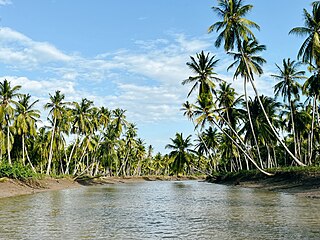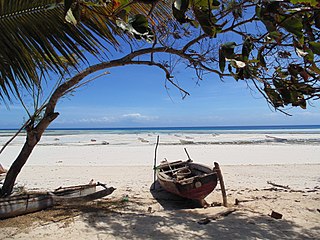
Zanzibar is an insular semi-autonomous region which united with Tanganyika in 1964 to form the United Republic of Tanzania. It is an archipelago in the Indian Ocean, 25–50 km (16–31 mi) off the coast of the African mainland, and consists of many small islands and two large ones: Unguja and Pemba Island. The capital is Zanzibar City, located on the island of Unguja. Its historic centre, Stone Town, is a World Heritage Site.
The Swahili people comprise mainly Bantu, Afro-Arab and Comorian ethnic groups inhabiting the Swahili coast, an area encompassing the Zanzibar archipelago and mainland Tanzania's seaboard, littoral Kenya, northern Mozambique, the Comoros Islands and Northwest Madagascar.

Pangani District Council is one of eleven administrative districts of Tanga Region in Tanzania. The District covers an area of 1,756 km2 (678 sq mi). It is bordered to the north by Muheza District, to the east by Zanzibar Channel, to the south by the Chalinze District of Pwani Region, and to the west by the Handeni District. The district is comparable in size to the land area of Guadeloupe. The district seat (capital) and largest settlement in Pangani district is the town of Pangani. The district is named after the historic Pangani River. As of the 2022 census, the population was Pangani district was 75,642, making it the least populous district in Tanga Region.

Unguja South Region, Zanzibar South Region or South Zanzibar Region is one of the 31 regions of Tanzania. The region covers an area of 854 km2 (330 sq mi). The region is comparable in size to the combined land area of the nation state of Kiribati. and the administrative region is located entirely on the island of Zanzibar. Unguja South Region is bordered on three sides to the south by Indian Ocean, northeast by Unguja North Region and northwest by Mjini Magharibi Region. The regional capital is the town of Koani. Besides being known for its Spinner dolphin populations, the region is also home to the oldest mosque in East Africa, the Kizimkazi Mosque and also historic Makunduchi town. The region has the fourth highest HDI in the country, making one of the most developed regions in the country. According to the 2022 census, the region has a total population of 195,873.

Swahili architecture is a term used to designate a whole range of diverse building traditions practiced or once practiced along the eastern and southeastern coasts of Africa. Rather than simple derivatives of Islamic architecture from the Arabic world, Swahili stone architecture is a distinct local product as a result of evolving social and religious traditions, environmental changes, and urban development.

The Kizimkazi Dimbani Mosque is a mosque Located in the town of Dimbani, Kusini District of Unguja South Region in Tanzania. It is situated on the southern tip of the island of Zanzibar in Tanzania and is one of the oldest Islamic buildings on the East African coast. Despite its name, it is located in Dimbani, not Kizimkazi, which is 3 miles away. According to a preserved kufic inscription, it was built in 1107. Although the inscription and certain coral-carved decorative elements date from the period of construction, the majority of the present structure was rebuilt in the 18th century.

The Swahili coast is a coastal area of East Africa, bordered by the Indian Ocean and inhabited by the Swahili people. It includes Sofala ; Mombasa, Gede, Pate Island, Lamu, and Malindi ; and Dar es Salaam and Kilwa. In addition, several coastal islands are included in the Swahili coast, such as Zanzibar and Comoros.
Chambani is a historic site and village located in Mkoani District of Pemba South Region. Its one of several National Historic sites on the island of Pemba. The site is located nine kilometres south of Chake-Chake, close to several sets of ruins, notably the Pujini Ruins, a 15th-century citadel, located close to the village of Pujini, two kilometres to the north.
The Shirazi also known as Mbwera, are a Bantu ethnic group inhabiting the Swahili coast and the nearby Indian ocean islands. They are particularly concentrated on the islands of Zanzibar, Pemba and Comoros.
The Hadimu are a Bantu ethnic and linguistic group native to the islands of Zanzibar and Pemba Island of Tanzania.

Samia Suluhu Hassan. is a Tanzanian politician who has served as president of Tanzania since 19 March 2021. She is the first Tanzanian woman and the second woman from the East-African region to serve in the position. She previously served as vice-president of Tanzania from 2015 to 2021, from which she ascended to the presidency following the death of her predecessor, John Magufuli.

Hussein Ali Mwinyi is the 8th president of Zanzibar. The son of former Tanzanian president Ali Hasan Mwinyi, he is a member of the Chama Cha Mapinduzi (CCM) political party.
A Swahili door or Zanzibari door is a door that was developed in the Swahili coast during the Middle Ages and peaked in the 19th century. The door is usually the first and foremost key element of Swahili architecture and was the historically first item that was built before the rest of the home.

Pujini Ruins is a Medieval historic site next to the village of Pujini located in Chake Chake District of Pemba South Region. There used to be a fortified palace at the site, only ruins of the walls remain. The palace is believed to have been of Mkame Mdume. Its one of several National Historic Sites on the island of Pemba including Chambani and Ras Mkumbuu.
Shamiani is protected historic site located inside Mkoani District of Pemba South Region in Tanzania. The site is home to partially excavated abandoned medieval Swahili ruins with a brief occupation period from about 14th to 16th century.

Msuka Mjini Ruins is protected historic site located inside Micheweni District of Pemba North Region in Tanzania. Msuka Mjini has a Swahili mosque from the fifteenth century preserved in ruins on the Kigomasha peninsula on the island. The date 816AH is carved on the interior of the circular mirhab.
Mkia wa Ng'ombe Ruins is protected historic site located inside Micheweni District of Pemba North Region in Tanzania. The settlement was established around the 15th CE and abandoned in the 16th century. There are ruins of a mosque, tombs and some stone buildings. The site is critically endangered to further erosion.

Kunduchi is a Medieval Swahili National Historic Site located in Kunduchi ward, located in Kinondoni District of Dar es Salaam Region in Tanzania. There is an excavated 15th-century mosque on the site. An 18th-century cemetery with the biggest collection of pillared tombs in East Africa, situated in a baobab woodland, and embellished with Ming era's porcelain plates. The pottery discovered here demonstrates the medieval town's affluence and trading connections with imperial China.

Oman–Tanzania relations are the diplomatic relations between Oman and Tanzania. The Sultanate of Oman has one of the oldest historical relationship with communities in Tanzania, namely in Zanzibar. Oman is the only country outside Africa where Swahili is spoken as a first language, and its people have blood relations with the people of Tanzania.

The Mafia Archipelago or The Mafia Islands is an group of islands across the Mafia Channel in the Mafia District of Pwani Region's coast on the Sea of Zanj in Tanzania's Indian Ocean coast. The archipelago is composed of 9 islands and around 12 coral reefs. In total, the Mafia archipelago covers 972 km2 (375 sq mi) in total, of which 8.5 km2 (3.3 sq mi) 407 km2 are land and 565 km2 are water. and has an average elevation of 53 m (174 ft). Of the 12 reefs in the archipelago the most famous one is the Tutia Reef. The nine Islands in the archipelago are. The largest island in the archipelago is Mafia Island also known as Chole Shamba locally. The other eight islands inside Mafia District in addition to Mafia Island are; Juani Island, Chole Island, Jibondo Island (Kibondo), Bwejuu Island, Shungumbili Island (Thanda), Barakuni Island, Miewi Island, and Niororo Island (Nyororo).















